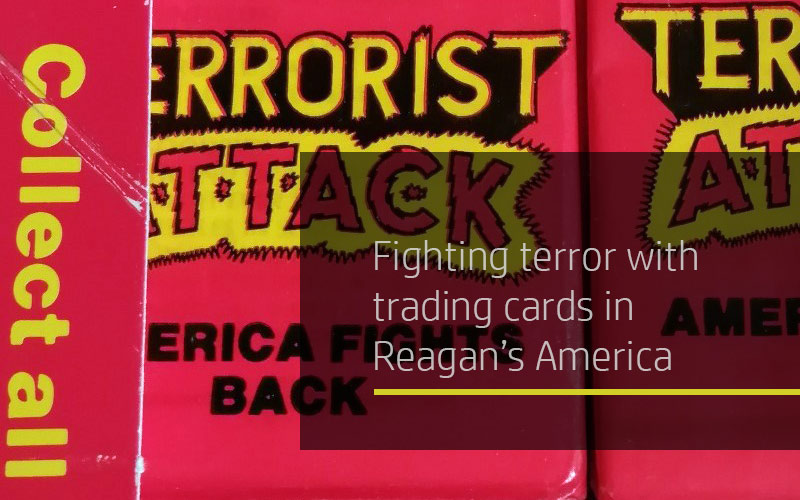
Fighting terror with trading cards in Reagan’s America
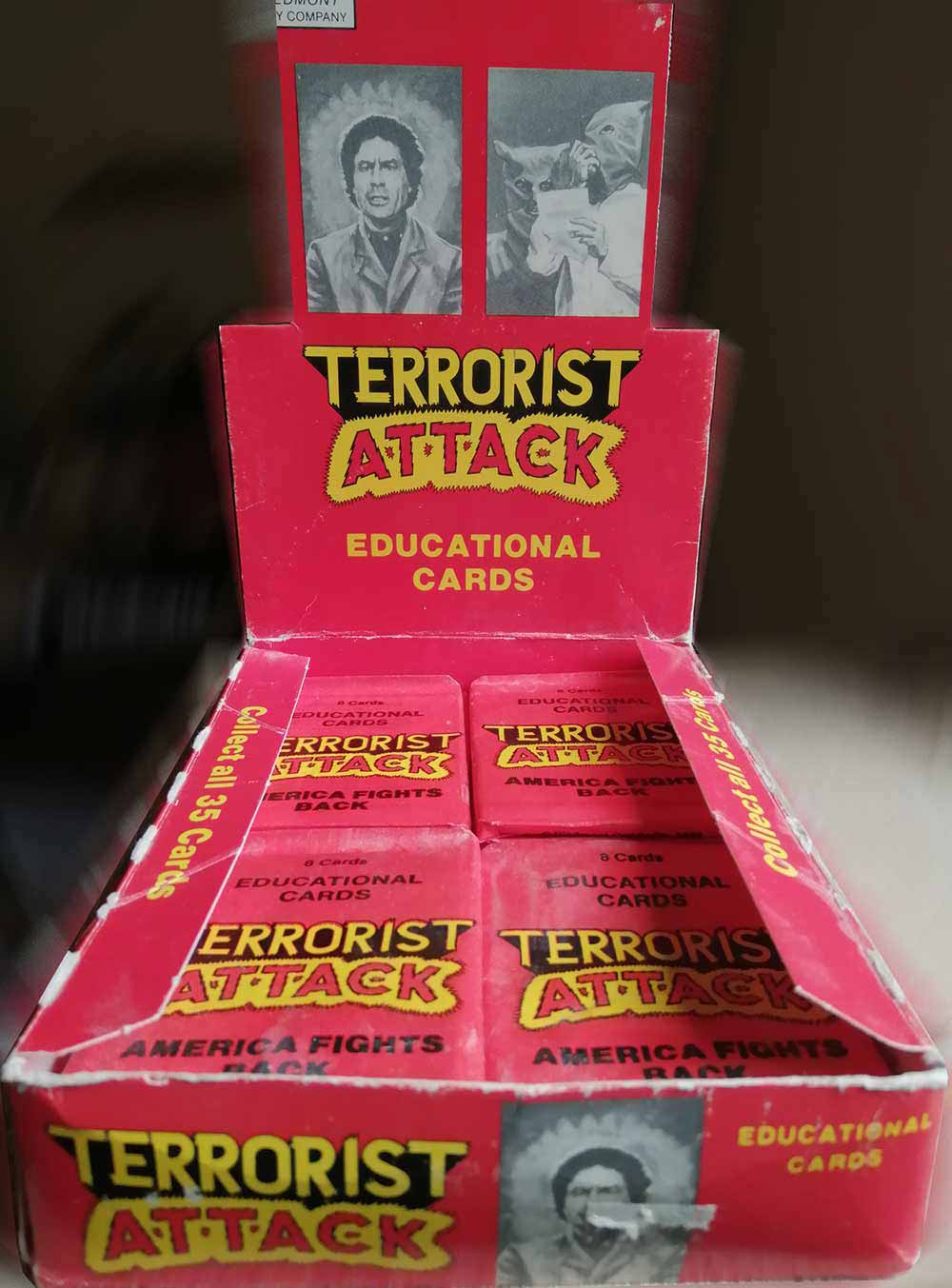
Perhaps in a few weeks, Tucson kids might be able to trade a Reggie Jackson or a Babe Ruth for a Moammar Gadhafi or a Charles Manson.
Ed Severson, Arizona Daily Star, 13 Sept. 1987
As David Kerekes mentioned in last week’s blog, lockdown leads you to delve into all those neglected bookshelves and cupboards, rediscovering things on your theoretical to-do list. Near the top of mine was finding out more about a set of trading cards that I bought several years ago at a London film fair: Terrorist Attack Educational Cards. Maybe it was because he’d been given the worst spot of all in the far corner of a room adjoining the main one, but the stallholder let me have the unopened display carton of cards for a mere £5.
There are 35 cards in the set, which is introduced on the header card as an opportunity to learn ‘about one of the most talked about and important subjects of our time: international terrorism’. The cards were released in mid 1987, with buyers at conventions apparently snapping them up. Underground comix legend Gary Arlington, of the San Francisco Comic Book Company, said he sold 72 packs the first day they were put on sale. Each pack – containing cards only, no gum – cost 40 or 50 cents.
Trading cards go back to the late 19th century, when they were included in packets of cereal and cigarettes – some of the most collectable are the baseball cards included with Old Judge cigarettes in the 1880s and nineties. In the 1930s several American companies began to pair baseball cards with gum, but this combination had become less of a selling point by the sixties and seventies. Robert Hendrickson, writing in The Great American Chewing Gum Book (1976), says that by that point gum had come to play second-fiddle to trading cards. One bubble gum ‘baron’ Hendrickson spoke to was confident that trading cards would sell equally well among children ‘with spinach- and liver-flavoured brands, or with no gum at all’. When you factored in growing numbers of adult collectors, the trading card market was booming, and many companies began to branch out into one-off non-sports sets.
This wasn’t an unprecedented move. War, in particular, had long been a theme of trading cards, albeit sporadically in response to conflicts. In the late 1930s the Bowman Gum Company accompanied its popular Blony gum with a series of over 200 cards graphically (and often xenophobically) depicting the Horrors of War. And Topps’ Friend or Foe cards aimed to train civilians in aircraft identification during the 1940s and fifties.
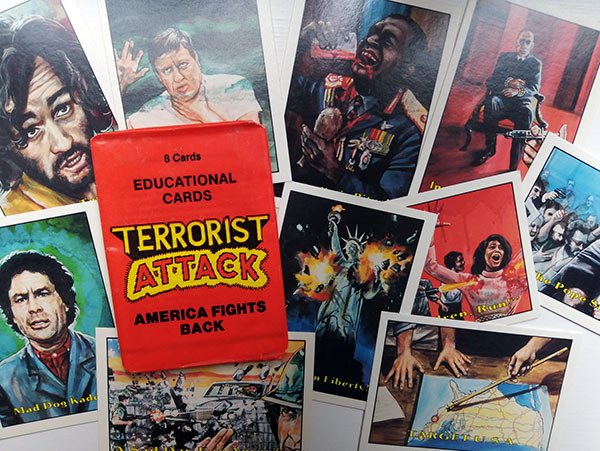
The Terrorist Attack cards, with the jingoistic slogan ‘America Fights Back’ printed on each packet, are perhaps closer in character to the Red Menace cards produced by Bowman in 1951. A mixture of documented events and fearful speculation, Terrorist Attack depicts named individuals as well as imaginary vignettes. Muammar Gaddafi appears three times, unsurprising considering his escalating actions during the 1980s and the Reagan administration’s counter-terrorism policy. Idi Amin is depicted gleefully downing a glass of blood. The inclusion of Charles Manson in the set is debateable, a rather debonair portrait of him appearing above the caption ‘American Terrorist’. There is a blood-soaked scene of a woman being shot as she exclaims “Run, children, run!” Pope John Paul II is almost assassinated as a horrified crowd looks on. The threat of nuclear war is hammered home: a giant mushroom cloud is simply captioned ‘GOODBYE!’, and a man runs screaming in the streets of New York, his skin melting from his face.
One of my immediate questions about the set was how it was received upon its release. Kurt Kuersteiner, writing for The Wrapper Magazine, refers to a card price guide that suggests the creators of Terrorist Attack kept their identities a secret due to fears of reprisal. Contemporary news coverage was relatively forthcoming, however. Rob Morse, writing for the San Francisco Examiner, revealed:
The man who invented these cards is Charles Mandel, president of Sports Design Products of Hazel Park, Mich., which makes baseball cards and other trading cards. He’s a hard man to find based on a pack of Terrorist Attack cards. The cards list Piedmont Candy Co. of Detroit as the manufacturer, but that’s a ruse Mandel employed to throw off terrorists.
Mandel described himself as “a rabid American right-winger,” and says he doesn’t care if the Terrorist Attack cards make money. He’s sending free cards to President Reagan, Secretary of State [George] Shultz and [National Security Council member] Ollie North.
There was some attempt to build mystique around the whole affair, though. Some news reports suggested that the company manager feared violent retaliation from his neighbours if it was revealed he was behind the cards. One distributor, who kept a Berkeley baseball card store stocked with the cards, refused to tell a San Francisco Chronicle reporter where the cards came from: “They come from a non-existent source, kind of like TV preachers.”
Although the artwork is uncredited, one newspaper article attributed it to Doug West of Sterling Heights, Michigan. Doug West specialized in sports illustration and, comparing the Terrorist Attack artwork to some of West’s baseball card illustrations, this seems likely. A friend of Mandel’s, Mark Lahti, penned the somewhat irreverent text for the cards: suicide drivers should ‘have their drivers’ licenses revoked!’, ‘Is there any fate worse than being married to a terrorist?’
Mandel, explaining his inspiration for the cards, nodded to the Garbage Pail Kids but there were other obvious comparisons. At Comics Archives in Detroit, store manager Bill Barker said: “They’re sort of like the Mars Attacks cards in 1964, which showed things like Martians roasting cows with flamethrowers. Now those are heavy collector’s items, selling for $7 to $10 a card.”
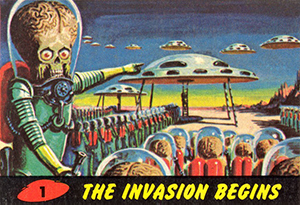
If Barker was hopeful that the cards were collector’s items in the making, others were less impressed. Mandel’s suggestion that the cards were an ideal way for parents to spend “quality time” with their children didn’t sway grassroots advocacy group Action for Children’s Television (ACT). By the mid 1980s ACT had succeeded in removing a slew of children’s programmes from the American airwaves and would shortly do the same for the Garbage Pail Kids TV series. President of ACT, Peggy Charren, said of Terrorist Attack:
It’s the kids who glom onto this, not adults, who would be properly nauseated. This kind of thing encourages children to think of terrorists as heroes. … I don’t think there’s a piece of pornography I’ve heard about lately that’s as bad as this.
Some stores refused to carry the cards, with one store owner declaring he’d be “darned if I’d carry anything like that”.
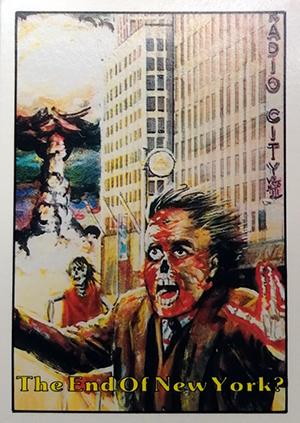
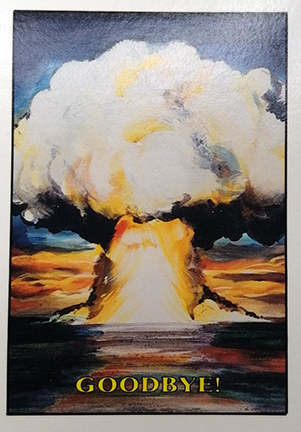
Terrorist Attack’s header card, perhaps attempting to balance out the threat of nuclear war or the bombing of the Statue of Liberty, reassured children that although ‘There are terrorists in many countries … the chance of you ever seeing one is very, very small.’ Things would change, of course. Years later, in the wake of 9/11, Topps announced its plan to produce the Enduring Freedom series, with cards including images of key political figures and information about military equipment. Bin Laden was included because, said Topps CEO Arthur Shorin, children might want to “stomp all over it, and dump it in the garbage”. Released in October 2001, much of the accompanying controversy was reminiscent of that surrounding Terrorist Attack: Were the cards ‘educational’? Would children be traumatized by their content? Unlike Terrorist Attack, Enduring Freedom didn’t fly off the shelves. One imagines Mandel would put that down to the lack of gore; he claimed to have added the more graphic cards to Terrorist Attack after being disappointed by the low shock value of the initial run.
Considering what he and Lahti might do next, Mandel noted in a 1987 interview that they were considering “a historical series … This one would deal with the likes of Caligula, Vlad the Impaler, Herod and some of the other more maniacal leaders through Hitler”. Much to the relief, or perhaps disappointment, of critics like Charren, this never happened as far as I can find out (but, speaking of maniacal leaders, there was this recent set from Topps). Today, you can bag a full set of Terrorist Attack cards for between £10 and £20 on eBay. Although they may not have the same appeal as iconic sets like Mars Attacks, they’re certainly an interesting historical artefact of 1980s America.
Jennifer Wallis
Like this article?
Related Posts
Comments
Copyright © Headpress

